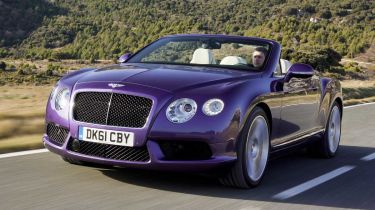Bentley Continental GTC V8 (2011-2018)
We get behind the wheel of the new V8-powered Bentley convertible

To cut fuel consumption by 40 per cent and make the Bentley GTC more thrilling to drive at the same time is an achievement. Drop the roof, floor the throttle and the muscular exhaust note dominates the experience – performance is virtually on a par with the W12 model, too. Grip and body control is excellent, considering the GTC’s bulk and ride quality, but the fingertip light steering could do with more feel. Whether you go for the Coupe or Convertible depends entirely on whether you prioritise driving dynamics or aural drama. Either way you’ll be buying a car that’s better to drive and cheaper to own than its W12 counterpart.
A small change has made a seismic difference to the Continental GT. As we discovered earlier this week, by fitting a smaller V8 engine to the Continental GT Bentley has not only improved fuel efficiency by 40 per cent, but transformed the car’s laid-back character to something more sporty. Does it have the same effect on the GTC?
Let’s cut to the chase, this V8 sounds incredible. Whereas the W12 model’s bassy tone seems stifled, the V8 has been allowed to sing. There’s a menacing burble at low speeds climaxing in a genuine muscle car roar at high revs, but the refinement is still there on constant throttle – especially with the three-layer roof in place.
Used - available now

2014 Bentley
Continental GT
42,000 milesAutomaticPetrol6.0L
Cash £36,495
2021 Bentley
Continental GT
33,950 milesAutomaticPetrol4.0L
Cash £134,995
2024 Bentley
Continental GT
23,900 milesAutomaticPetrol4.0L
Cash £129,490
2014 Bentley
Continental GT
26,650 milesAutomaticPetrol6.0L
Cash £43,995Peeling the heavy canvas hood back takes the motors 25 seconds, and can be done at speeds of up to 20mph. The noise with it stowed is sublime – enough to recommend this car over the W12 version alone, but the benefits of the V8 engine don’t stop there.
Fuel consumption probably doesn’t rank very high on a Bentley owner’s list of priorities, but a leap from 17.1mpg in the W12 GTC to 25.9mpg should catch their eye. It’s achieved through a combination of direct-injection, a smaller cubic capacity and a new eight-speed automatic gearbox, which works brilliantly apart from the column mounted paddles, which are tricky to locate once you’ve applied some lock. There’s also smart technology that shuts down four of the eight cylinders under light throttle loads – a similar system is already fitted to the Mulsanne’s 6.75-litre V8.
Efficiency hasn’t come at the expense of performance though. Bury the throttle and the thrust feels every bit as intense as the W12. In fact, the speed with which it revs, accompanied by the heavy metal soundtrack makes the experience even more intense. In a straight drag race from 0-60mph it loses out to the 12-cylinder model by two tenths of a second and its 187mph top speed lags by 8mph, but in the real world it’s as fast as you’ll want to travel in a car approaching 2.5 tonnes.
Maximum torque of 660Nm is only 40Nm less than the W12 and arrives at just 1,700rpm, so should you choose to waft along in a high gear, it’s more than happy to do so. Take it by the scruff of the neck though, and the GTC trails some way behind the GT. There’s 25kg less weight over the front axle, but its barely noticeable in the convertible – because the steering feels so much lighter than the coupe. It’s still quicker and more direct than on the Mulsanne, but with zero feedback it’s difficult to place the car accurately in corners.
Thanks to the impressive body control, lack of flex in the chassis and a four-wheel-drive system that grips the tarmac and refuses to let go, you can still cover ground at an alarming rate. Carry too much speed into a bend and eventually understeer takes over, and under heavy use the brakes will wilt (even if you option the £10,200 carbon discs), but who buys a Bentley with track work in mind?
Besides the wall of noise coming from the unique figure of eight tailpipes, there are a handful of ways to distinguish the V8 model from the W12. Winged ‘B’ badges on the bonnet and boot are finished with a red background – a cue that stretches back as far as the 1920s where it was used to denote the smaller models in the range. A three-section front bumper is specific to the V8, as is a black gloss grille surrounded by chrome.







